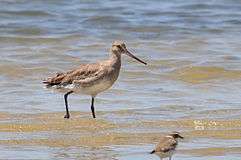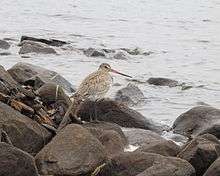Hudsonian godwit
| Hudsonian godwit | |
|---|---|
 | |
| Scientific classification | |
| Kingdom: | Animalia |
| Phylum: | Chordata |
| Class: | Aves |
| Order: | Charadriiformes |
| Family: | Scolopacidae |
| Genus: | Limosa |
| Species: | L. haemastica |
| Binomial name | |
| Limosa haemastica (Linnaeus, 1758) | |
The Hudsonian godwit (Limosa haemastica) is a large shorebird in the sandpiper family.Scolopacidae. The genus name Limosa is from Latin and means "muddy", from limus, "mud". The specific haemastica is from Ancient Greek and means "bloody". An 18th century name for this bird was red-breasted godwit.[2] The English term "godwit" was first recorded in about 1416–7 and is believed to imitate the bird's call.[3]
Identification
Adults have long dark legs and a long pink bill with a slight upward curve and dark at the tip. The upper parts are mottled brown and the underparts are chestnut. The tail is black and the rump is white. They show black wing linings in flight. The legs and feet are bluish-grey.[4]
| Standard Measurements[4][5] | |
|---|---|
| length | 14.5–16.7 in (370–420 mm) |
| weight | 300 g (11 oz) |
| wingspan | 29 in (740 mm) |
| wing | 195.5–208.5 mm (7.70–8.21 in) |
| tail | 70–83.8 mm (2.76–3.30 in) |
| culmen | 68.2–81.2 mm (2.69–3.20 in) |
| tarsus | 53.5–59.5 mm (2.11–2.34 in) |
Breeding
Their breeding habitat is the far north near the tree line in northwestern Canada and Alaska, also on the shores of Hudson Bay. They nest on the ground, in a well-concealed location in a marshy area. The female usually lays 4 olive-buff eggs marked with darker splotches. Incubation period is 22 days.[4] Both parents look after the young birds, who find their own food and are able to fly within a month of hatching.

Migration
They migrate to South America. These birds gather at James Bay before fall migration. In good weather, many birds make the trip south without stopping. They are vagrants to Europe, Australia, and South Africa.
They can perhaps be most easily seen in migration on the east coast of North America where they can be plentiful in migration in late July through early August.
Diet
These birds forage by probing in shallow water. They mainly eat insects and crustaceans.
Conservation history
Their numbers were reduced by hunting at the end of the 19th century.
References
- ↑ BirdLife International (2012). "Limosa haemastica". IUCN Red List of Threatened Species. Version 2013.2. International Union for Conservation of Nature. Retrieved 26 November 2013.
- ↑ Jobling, James A (2010). The Helm Dictionary of Scientific Bird Names. London: Christopher Helm. pp. 184, 227. ISBN 978-1-4081-2501-4.
- ↑ "Godwit". Oxford English Dictionary (3rd ed.). Oxford University Press. September 2005. (Subscription or UK public library membership required.)
- 1 2 3 Godfrey, W. Earl (1966). The Birds of Canada. Ottawa: National Museum of Canada. p. 163.
- ↑ Sibley, David Allen (2000). The Sibley Guide to Birds. New York: Knopf. p. 177. ISBN 0-679-45122-6.
External links
| Wikimedia Commons has media related to Limosa haemastica. |
| Wikispecies has information related to: Limosa haemastica |
- Hudsonian godwit - Limosa haemastica - USGS Patuxent Bird Identification InfoCenter
- Hudsonian godwit Species Account - Cornell Lab of Ornithology
- "Hudsonian godwit media". Internet Bird Collection.
- Hudsonian godwit photo gallery at VIREO (Drexel University)
- Interactive range map of Limosa haemastica at IUCN Red List maps
- Audio recordings of Hudsonian godwit on Xeno-canto.
